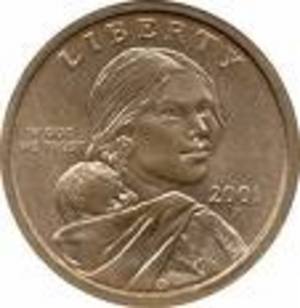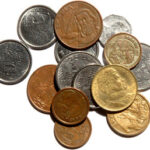Think about it: when was the last time anyone handed you a U.S. Sacagawea $1 dollar coin in change? Or, before that, a Susan B. Anthony or one of the new Presidential series $1 coins?
If you can actually reply with an instance then you are a rare person indeed. The fact is, U.S. dollar coins do not freely circulate as intended. Oh, they have a special interest following among coin collectors, and perhaps the Presidential $1 coins will be in greater demand than the ‘Susie’s’ or ‘Sacs’ ever were because their life span will include all our Presidents on them, making them a collectible series.
But caveat emptor, folks. Counterfeit Sacagawea dollars exist!
Okay, chances are you probably will not see one in the U.S., but they are available and in circulation in parts of South America. More about this further down. Let’s set up this story with some interesting background.
The much touted Sacagawea Dollar coin, once confusingly marketed by politically correct supporters at the U.S. Mint as the “Golden Dollar,” and the Susan B. Anthony dollar coin were both dismal and expensive failures, especially the Sac dollar.
So unpopular is the Sac dollar that almost from the first day they were struck in 2000, millions of Sacagawea dollars began cluttering up mint or Treasury Department vaults. They just weren’t in demand in the marketplace. Consequently, the only ones produced in recent years have been specimens for inclusion in Mint Sets or specifically for sale to collectors and dealers….with a big emphasis on the latter, who believe it or not, retail them at prices above face value.
But wait a minute. If these coins are so unpopular and unwanted why would anyone spend the money and effort counterfeiting them? You read that right: counterfeiting Sacagawea dollars! Almost as fast as bags of genuine Sacagawea dollars were being unloaded in Ecuador, counterfeiters in Columbia were sending bags of their bogus Sac dollars to the same Ecuadorian airport.
In 2002, within months after Sacagawea dollars began circulating in Ecuador, The U.S. Secret Service, working with Columbian authorities, broke up a major counterfeiting operation in Bogotá. Upwards of one million counterfeit U.S. $1 coins had been minted for use in Ecuador, and a goodly number reportedly made it onto the streets. The counterfeit coin’s diameter, thickness, and weight were within tolerance of genuine Sacagawea Dollars, but the metal, as previously noted, was not the three-layer sandwich material legitimate Sac dollars are made from. Additionally, rather than the expected golden color, the counterfeit coins appear more of a copper color.
Why Ecuador, you ask? Well, the Sacagawea dollars may be unwanted and unused in the United States, but most people are unaware that in September, 2000, U.S. currency officially became legal tender throughout Ecuador in an effort to stabilize the South American nation’s shaky economy and rampant inflation of the up-till-then monetary unit, the sucre.
At the time, my public relations agency represented the Ecuadorian cruise ship Galapagos Explorer II and business dealings had me traveling to Ecuador and South America every other month. Consequently, I was aware of the move making U.S. currency legal tender in Ecuador quite some time before it actually happened. I found it amusing that the U.S. had found a place to circulate all those Sac dollars it was minting and which nobody in the U.S. really wanted.
Somebody at the mint, perhaps tired of stubbing their toes on bags of Sac dollars in the vaults, had a brain storm and commencing on April 15, 2002 the U.S. began sending some $500 million of the unwanted dollar coins to Ecuador for use as circulating currency. And, wow, did they circulate! So much so that in less than a year they became the most popular currency item in the country. Surveys in Ecuador shortly after the coins were introduced there found that a majority of the population wanted the $1 coin. But there were also grumblings that a pocket full of dollar coins would be heavy and rip through pockets.
But besides no more stubbed toes, deporting $500-million U.S. Sac dollar coins to Ecuador solved two other problems for the mint: first of all, it greatly reduced the printing, labor, and shipping costs of producing replacement greenbacks for Ecuador every six months. Second, the Mint could take a deep breath of relief for finding something to do with the thousands of tons of dollar coins the American public apparently really didn’t want in the first place.
Many uninformed Ecuadorians believe the central device on the obverse is that of an Ecuadorian woman from the mountains. They know nothing of Sacagawea or the exaggerated role the politically correct U.S. Mint spin doctors gave to her being part of the Lewis & Clark expedition.
You may recall that Sacagawea dollars made their debut amid much fanfare, advertising, and expensive, persistent, public relations hype and that a total of 1.3 billion golden-colored dollar coins were minted during the first two years. Some 800 million were distributed to banks nationwide and earmarked to enter circulation. Though many people put one, or a few, aside as keepsakes or for posterity, the simple truth was the $1 coins were not being used for their intended purpose: circulating currency that would have a much longer life expectancy than the average 22 months of U.S. paper dollar, and therefore be more economical.
But let’s back up a bit. Why would anyone take the time to counterfeit Sacagawea Dollars? Isn’t it expensive to purchase machinery and material and other equipment to make the dies and planchets, then striking the coins, and then distributing the counterfeits? How could this be profitable?
One government official of questionable honesty in Ecuador told this writer that it is really easier to make bogus coins, of any nation, than paper currency. For one thing the quality of the paper used for currency is difficult to duplicate, and large quantity purchases of similar type papers that might get by many people sound alarms to law enforcement authorities.
On the other hand, little attention is paid to purchases of metal, meaning no immediate paper trail. And when the counterfeit coin makers are not overly particular with the quality of the metal (as is often the case) it really muddies up the waters. When we finished talking this fellow tried to sell me a ‘genuine’ Rolex watch for only $50 and a ‘real’ Guicci handbag for my wife at a third of the price they go for in Toronto.
If the above isn’t weird enough, a Secret Service source told us that they also found counterfeit Susan B. Anthony dollars. They didn’t say when or if they were connected to the present gang.
Though every so often there are reports of counterfeiters making twenty, fifty, and hundred dollar bills, counterfeiting coins is nothing new. But at least counterfeiting dollar coins to pass on some unsuspecting Ecuadorians is a bit more understandable than the bogus “Hennings Nickels” in the 1950’s. Francis Hennings actually counterfeited U.S. nickel five cent coins. He figured nobody ever paid much attention to small coins they received in change. And, he supposed, who would even think anyone would counterfeit a lowly Nickel? Hennings fakes were so good that the U.S. Mint initially authenticated them.
Now, decades later, we hear that some enterprising crooks south of the border have produced fake Sac dollars and, earlier, somebody was making knock-off Susan B. Anthony dollars.
I never cared much for the real Sacs and Susie’s anyway.




